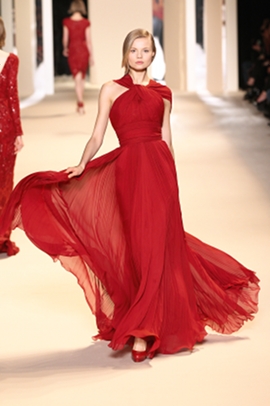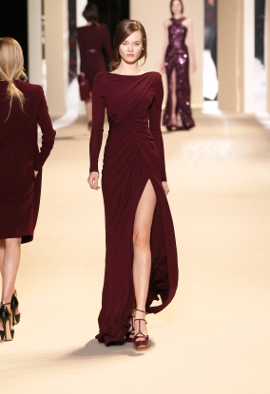Elie Saab, Lebanon

Elie Saab)
Elie Saab began his sartorial career by cutting cloth and drawing sketches for his sisters at home in Beirut, the Republic of Lebanon (Lebanon). Sewing table cloths and curtains into new designs, the nine-year-old was learning for himself how to cut clothes to the curve. In 1982, when he was only eighteen years old, the largely self-trained designer opened his own fashion store in Beirut.
From humble beginnings at the kitchen table, Mr. Saab’s elegant dresses with soft edges and exquisite detail are today worn by the rich and famous around the world in fashionable locations such as Beirut, Hong Kong, London, Los Angeles, Madrid, Moscow, New York, and Paris.
The entrepreneur’s dazzling rise from obscurity to international haute couture superstardom, and his seemingly infinite ability to innovate, has led industry experts to refer to him as a “precocious genius”.
Research and development
In 1981, Mr. Saab went to Paris to study fashion, but he soon returned to Beirut and opened his first workshop – with fifteen employees – a year later. Despite the challenges of the Lebanese civil war, the young designer found inspiration for his research and development (R&D) not only in the pre-war French influences in Beirut, but also in the Lebanese themselves.
Lebanese elegance is particularly evident in women’s evening gowns which often appear in flowing, intricately stiched, fully studded dresses with clean and simple lines. “The culture is in the dress, in the cut and the shape, with layers and movement. And there’s also the embroidery. It’s these small details that make a difference,” said Amine Jreissati, fashion editor for Marie Claire Arabia – a well-established fashion magazine.
Indeed, in the old neighborhoods of Beirut, there is an intricate and thriving network of small ready-to-wear boutiques and textiles shops. It is in this context of dressmaking entrepreneurship that the young Elie Saab was inducted into the world of fashion. “I grew up surrounded by beautiful women. Lebanese women are always elegant…,” said Mr. Saab.

Elie Saab)
Eli Saab designs are noted therefore for their fusion of Arabic and Western influences. The designer prefers to use rich materials such as taffeta (a woven fabric made of silk), organza (also made of silk), and satin intertwined with liquid fabrics such as muslin and lace. Mr.Saab’s dresses often incorporate sequins, semi-precious stones, and Swarovski crystals (a kind of precisely-cut lead crystal manufactured by the Swarovski AG company from the Republic of Austria) stitched into feminine curves and shapes.
To keep up with increasing demand for his stylish dresses, in 2005 Elie Saab opened new headquarters located in the heart of the highly fashionable Down Town area of Beirut.
With an R&D department that includes a couture production, a studio, a boutique, and two hundred and twenty qualified and experienced staff, as of 2011 Mr. Saab was well-placed to expand into new areas of fashion and design.
Branding, commercialization and licensing
Inspired by his surroundings and the people in his life, Mr. Saab showcased his first set of designs in the early 1990s at the Casino du Liban, in Beirut. Elie Saab House Design and Art in Beirut – as the showcase was called – was a sensational hit which spread the designer’s name to the French Republic (France), the Swiss Confederation (Switzerland), and other countries.
In 1997, Elie Saab became the first non-Italian haute couture member of the prestigious Camera Nazionale della Moda – the premiere association promoting fashion in the Italian Republic (Italy). By 1998, Mr. Saab’s fame was such that he started a ready-to-wear line of clothes in Milan and in the same year held a fashion show in the Principality of Monaco.
Having become an eminent designer in Italy, in 2002 Eli Saab’s fame reached new heights when Halle Berry wore one of his designs to receive the Oscar for Best Actress, thus becoming the first Lebanese designer to dress an Oscar Academy Award winner.
With his name assured in the annals of design history and his designs acknowledged by industry experts, the Chambre Sundicale de la Haute Couture – the French fashion industry’s governing body – invited Mr. Saab to become a member in 2000. In July of the same year, Mr. Saab showed his first haute couture collection in Paris. Three years later, the designer showcased his first ready-to-wear collection for Paris; the city subsequently became his permanent ready-to-wear runway.
Aware of the marketing potential of a well-branded product, Elie Saab maintains a variety of new brands in a portfolio aimed at attracting new customers. The label Elie Saab, moreover, has developed three main lines: ELIE SAAB Couture, Elie Saab Ready to Wear, and Elie SAAB ACCESSORIES. Another bridal line is sold all over the world through a Spanish bridal company – Pronovias – under the “Elie by ELIE SAAB” brand.
Furthermore, in 2009 Elie Saab announced a ten years licensing contract with Beaute Prestige International (BPI) – an internationally renowned perfumery – to begin producing Elie Saab perfumes in early 2011. “Creating a fragrance has become an essential step of the development of our couture house. We have chosen BPI as a partner who is able to actualize our ambitions,” said Mr. Saab.

Elie Saab)
Further augmenting his brand portfolio, in 2010, Mr. Saab signed a design contract with Weyves International (WI), a yatch maker based in London, the United Kingdom (UK). Mr. Saab was commissioned as an interior and exterior designer for new a range of luxury mega yatchs for WI. “Designing a yatch and conceiving of its art of living constitute a perfect opportunity to expand my brand’s universe…,” said Mr. Saab.
As of 2011, the designer’s ready to wear clothes are distributed throughout the world through selective stores. The company continues to expand its product portfolio, using its brand equity to venture into new business opportunities.
Trademarks
Although Elie Saab is a well-known name, the company recognizes the benefits of protecting its brands through the registration of trademarks.
Wishing to expand into the United States of America (USA) and other international markets, in 2004 Elie Saab™ was registered as a trademark using the Madrid System of the international registration of marks at the World Intellectual Property Organization (WIPO).
In 2009, the company filed for trademark in the European Union (EU), one of its biggest markets, also via WIPO.
With his trade name protected by the intellectual property (IP) system, the designer has been able to expand the company’s brand portfolio and open up new commercialization opportunities.
Business results
Not only receiving international accolades, the designer has became a national celebrity and his name a byword for style and elegance in Lebanon. In recognition of his service to the Lebanese fashion industry, in 2003 the designer received the title of Chevalier de L’Ordre National du Ce’dre Republic from the Lebanese government.
Moreover, in 2007 Elie Saab’s first flagship store outside Lebanon was opened in the capital of fashion, at 1 Rond point des Champs-Elysees, in Paris, France. A year later, the company opened its first boutique in London, UK, at the prestigious Harrods department store. Furthermore, in 2010 Elie Saab opened a new boutique in the illustrious Dubai Mall in the United Arab Emirates.
Mr. Saab’s designs continue to amaze and dazzle on catwalks across the world, and have become a common choice and favorite amongst A-list celebrities including royals such as the stylish queen Rania of the Hashemite Kingdom of Jordan.
The first cut
Elie Saab made his first cut into the world of fashion as a child in a kitchen in Beirut. Since then, the designer’s prodigious talent has inspired others by showing how well-made cut-to-the-curve clothing can lead to a well-known brand name well worth protecting with registered trademarks.
Source: WIPO

 Client Focus
Client Focus